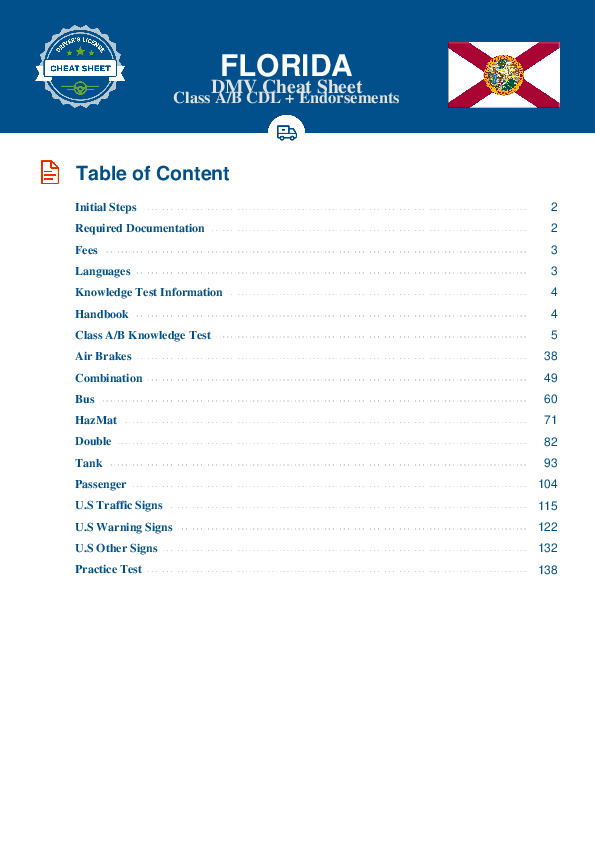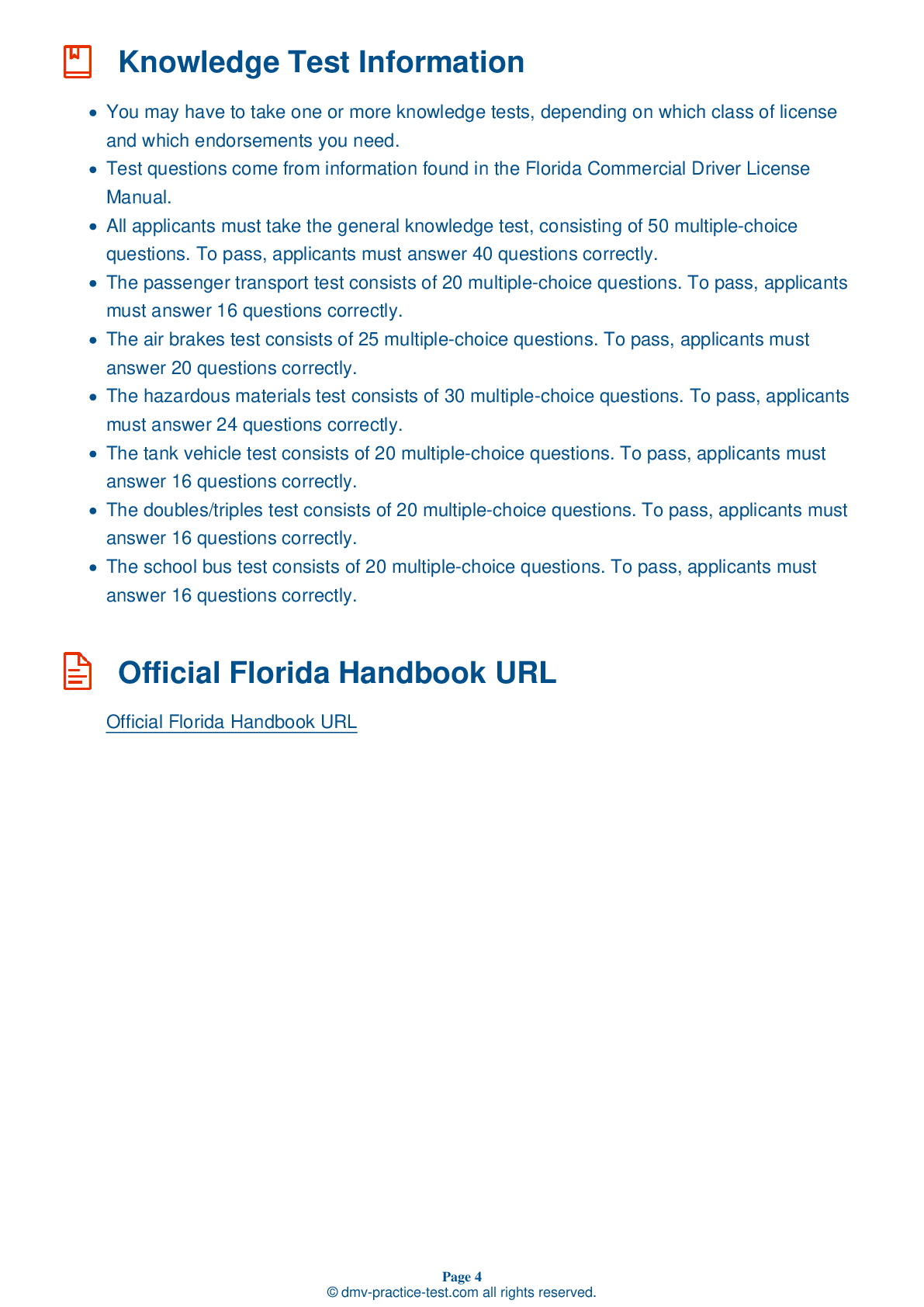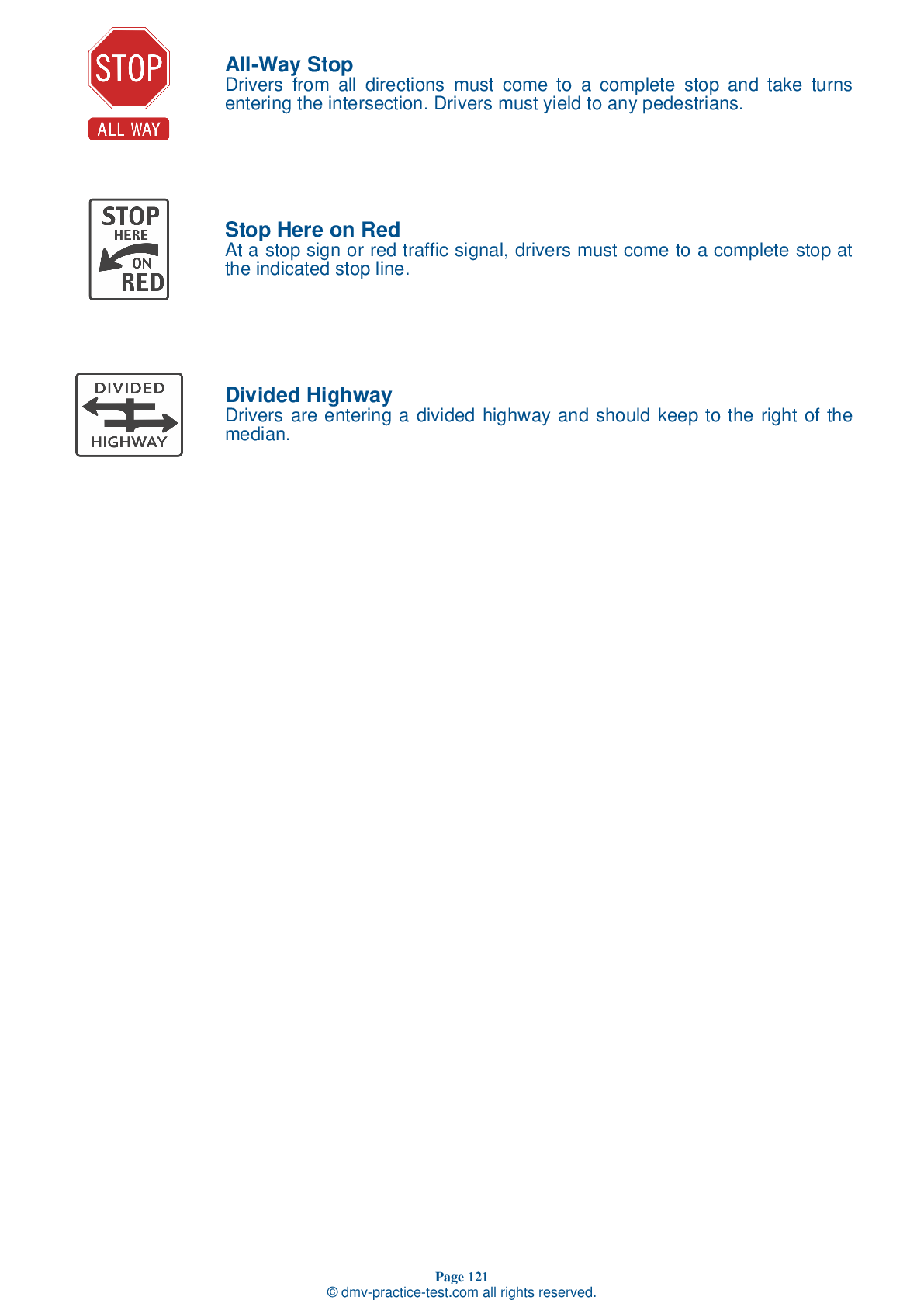Combination #1
Combination Vehicles Practice Test | Florida 2025 #1
Train for FREE online with our Florida CDL combination vehicle test. The official exam test consists of several obligatory parts, with all of them checking your knowledge of different blocks of road rules. If you need to obtain a FL combination license in 2025, practice as much as possible. Free sample tests published on our website will help you check and improve your knowledge and boost your grades. Please bear in mind that DMV requirements for issuing a combination license may vary from state to state.
20
16
20
1 . Rollovers happen when drivers:
Drive illegally.
A rollover happens as a result of a driver taking a turn at too high a speed. Be sure to take turns and curves safely and slowly.
2 . Look for matching colors when coupling glad hands. Service lines are often:
Blue.
When coupling glad hands, make sure to couple together matching glad hands. To help drivers avoid mistakes, color coding is sometimes used. Service lines are often coded with the color blue and emergency lines are often coded with the color red.
3 . Pull out the trailer air supply control to test:
The landing gear.
Be sure to test the trailer emergency brakes before beginning a trip. After ensuring that the trailer rolls freely, you can test the emergency brakes by pulling out the trailer air supply control, or placing it in the "emergency" position. Pull forward slightly with the tractor and make sure the trailer does not move.
4 . Large combination vehicles take the longest amount of time to stop:
When mostly loaded.
Large combination vehicles take longer to stop when they are empty than when they are loaded. The decreased weight causes a vehicle's wheels to have decreased traction on the surface of the road.
5 . The trailer hand valve:
Should only be used when transporting cargo.
The trailer hand valve should not be used for parking. This could cause all of the air to leak out of the braking system, resulting in the brakes releasing. Instead, use the parking brake.
6 . A lightly-loaded combination vehicle will stop more slowly than a fully-loaded vehicle because:
The suspension springs only operate when a trailer reaches a minimum weight.
An empty combination vehicle will come to a complete stop more slowly than a fully-loaded vehicle. The stiff suspension springs and strong brakes will have lower traction on a light trailer than they would if the vehicle carried more weight.
7 . The best way to recognize that your trailer has begun to skid is by:
Listening to the radio.
The earliest and best way to recognize the beginnings of a trailer skid is by seeing the trailer veer off-course in your mirrors.
2025 Florida | Frequently Asked Questions
In Florida, a Commercial Driver's License (CDL) Class B is a type of license required to operate vehicles with a Gross Vehicle Weight Rating (GVWR) of more than 26,000 pounds. It also allows the holder to tow vehicles that weigh less than 10,000 pounds. This includes buses, dump trucks, delivery trucks, and straight trucks.
A Class B CDL license in Florida allows the holder to operate single vehicles with a Gross Vehicle Weight Rating (GVWR) of 26,001 pounds or more, or any such vehicle towing another not in excess of 10,000 pounds. This includes vehicles like city buses, tourist buses, segmented buses, delivery trucks, dump trucks, and utility trucks.
To acquire a Class B CDL license in Florida, an applicant must be at least 18 years old (21 for interstate driving), possess a valid Florida driver's license, pass a vision test, and successfully complete the General Knowledge test. Additionally, an applicant must pass the pre-trip, basic controls and road test for the desired vehicle. A medical examination report is also required.
In Florida, you must be at least 18 years old to qualify for a Class B Commercial Driver's License (CDL) for intrastate driving (within Florida only). However, you must be 21 years or older to qualify for interstate driving (across state lines or transporting hazardous materials).
Specific endorsements are not necessary for a Class B CDL license, but they can broaden your driving capabilities. Endorsements allow you to drive certain types of vehicles or transport specific goods. For example, a passenger or school bus endorsement allows you to drive large buses, while a hazardous materials endorsement allows you to transport hazardous materials.
The Class B CDL skills assessment in Florida includes three parts: a pre-trip inspection, a basic vehicle control test, and an on-road driving test. The pre-trip inspection tests your knowledge on vehicle safety, the basic vehicle control test checks your ability to maneuver the vehicle, and the on-road driving test assesses your practical driving skills in various traffic situations.
Yes, Class B CDL license holders in Florida are restricted to driving single vehicles with a gross vehicle weight rating (GVWR) of 26,001 pounds or more, or a towing vehicle not exceeding 10,000 pounds GVWR. They cannot operate Class A vehicles unless they upgrade their license. Also, without specific endorsements, they cannot transport passengers or hazardous materials.
In Florida, the written Class B CDL test is primarily offered in English. However, some locations may provide the test in Spanish. It's important to note that federal regulations require all commercial drivers to understand and read English well enough to converse with the general public, understand traffic signs and signals, respond to official inquiries, and make entries on reports and records.
Yes, you can request test accommodations for the Florida Class B CDL written exam if you have a disability. The Florida Department of Highway Safety and Motor Vehicles (DHSMV) complies with the Americans with Disabilities Act (ADA) and provides modifications or aids to help individuals with disabilities take the test. However, you must provide documentation supporting your need for accommodation.
If you don't pass the Class B CDL written test in Florida, you can retake it. However, you must wait until the next business day to do so. If you fail the test three times, you will need to complete a state-approved driver education course before attempting the test again. Keep in mind that each retest comes with an additional fee.



